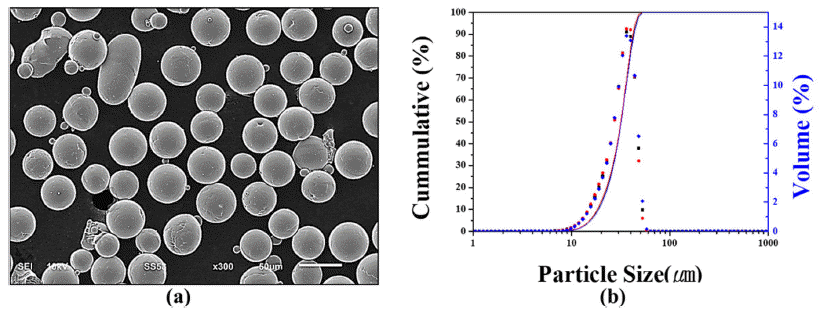Search
- Page Path
- HOME > Search
- [Korean]
- Characterization and Classification of Pores in Metal 3D Printing Materials with X-ray Tomography and Machine Learning
- Eun-Ah Kim, Se-Hun Kwon, Dong-Yeol Yang, Ji-Hun Yu, Kwon-Ill Kim, Hak-Sung Lee
- J Korean Powder Metall Inst. 2021;28(3):208-215. Published online June 1, 2021
- DOI: https://doi.org/10.4150/KPMI.2021.28.3.208

- 449 View
- 12 Download
-
 Abstract
Abstract
 PDF
PDF Metal three-dimensional (3D) printing is an important emerging processing method in powder metallurgy. There are many successful applications of additive manufacturing. However, processing parameters such as laser power and scan speed must be manually optimized despite the development of artificial intelligence. Automatic calibration using information in an additive manufacturing database is desirable. In this study, 15 commercial pure titanium samples are processed under different conditions, and the 3D pore structures are characterized by X-ray tomography. These samples are easily classified into three categories, unmelted, well melted, or overmelted, depending on the laser energy density. Using more than 10,000 projected images for each category, convolutional neural networks are applied, and almost perfect classification of these samples is obtained. This result demonstrates that machine learning methods based on X-ray tomography can be helpful to automatically identify more suitable processing parameters.
- [Korean]
- Optimization of PEALD-Ru Process using Ru(EtCp)2
- Se-Hun Kwon, Young-Keun Jeong
- J Korean Powder Metall Inst. 2013;20(1):19-23.
- DOI: https://doi.org/10.4150/KPMI.2013.20.1.019

- 310 View
- 4 Download
-
 Abstract
Abstract
 PDF
PDF - Ru films were successfully prepared by plasma-enhanced atomic layer deposition (PEALD) using Ru(EtCp)_2 and NH_3 plasma. To optimize Ru PEALD process, the effect of growth temperature, NH_3 plasma power and NH_3 plasma time on the growth rate and preferred orientation of the deposited film was systemically investigated. At a growth temperature of 270circC and NH_3 plasma power of 100W, the saturated growth rate of 0.038 nm/cycle was obtained on the flat SiO_2/Si substrate when the Ru(EtCp)_2 and NH_3 plasma time was 7 and 10 sec, respectively. When the growth temperature was decreased, however, an increased NH_3 plasma time was required to obtain a saturated growth rate of 0.038 nm/cycle. Also, NH_3 plasma power higher than 40 W was required to obtain a saturated growth rate of 0.038 nm/cycle even at a growth temperature of 270°C. However, (002) preferred orientation of Ru film was only observed at higher plasma power than 100W. Moreover, the saturation condition obtained on the flat SiO_2/Si substrate resulted in poor step coverage of Ru on the trench pattern with an aspect ratio of 8:1, and longer NH_3 plasma time improved the step coverage.
- [Korean]
- Coatings Properties and Efficiency Performance of Cr-DLC Films Deposited by Hybrid Linear Ion Source for Hydraulic Gear Pump
- Sun-Yong Cha, Wang-Ryeol Kim, Min-Suk Park, Se-Hun Kwon, Won-Sub Chung, Myung-Chang Kang
- J Korean Powder Metall Inst. 2010;17(6):456-463.
- DOI: https://doi.org/10.4150/KPMI.2010.17.6.456

- 226 View
- 1 Download
-
 Abstract
Abstract
 PDF
PDF - This paper describes the results of the application of Cr-Diamond-like carbon (DLC) films for efficiency improvement through surface modification of spur gear parts in the hydraulic gear pump. Cr-DLC films were successfully deposited on SCM 415 substrates by a hybrid coating process using linear ion source (LIS) and magnetron sputtering method. The characteristics of the films were systematically investigated using FE-SEM, nano-indentation, sliding tester and AFM instrument. The microstructure of Cr-DLC films turned into the dense and fine grains with relatively preferred orientation. The thickness formed in our Cr buffer layer and DLC coating layer were obtained the 487 nm and 1.14;µm. The average friction coefficient of Cr-DLC films considerably decreased to 0.15 for 0.50 of uncoated SCM415 material. The hardness and surface roughness of Cr-DLC films were measured 20 GPa and 10.76 nm, respectively. And then, efficiency tests were performed on the hydraulic gear pump to investigate the efficiency performance of the Cr-DLC coated spur gear. The experimental results show that the volumetric and mechanical efficiency of hydraulic gear pump using the Cr-DLC spur gear were improved up to 2~5% and better efficiency improvement could be attributed to its excellent microstructure, higher hardness, and lower friction coefficient. This conclusion proves the feasibility in the efficiency improvement of hydraulic gear pump for industrial applications.
- [Korean]
- The Effect of Electrical Characteristics and Electrode Shape on Alignment of Multi-walled Carbon Nanotubes
- Se-Hun Kwon, Young-Keun Jeong, Chang-Sik Jung, Myung-Chang Kang, Hyung-Woo Lee
- J Korean Powder Metall Inst. 2010;17(4):326-335.
- DOI: https://doi.org/10.4150/KPMI.2010.17.4.326

- 200 View
- 0 Download
-
 Abstract
Abstract
 PDF
PDF - In this paper, the effect of electrical characteristics and electrode shape on the alignment and attachment of multi-walled carbon nanotubes (MWNTs) has been studied. The attraction and alignment of MWNTs between the gaps has been investigated by applying electric field which is called electrophoresis and dielectrophoresis. According to the frequency of electric field, positive or negative dielectrophoretic force can be determined. The concentration of MWNTs solution was 5;µg/ml, and a droplet of 1.0sim1.5;µl was dropped between two electrodes. Through the repeated experiments, the optimal electrical conditions for aligning and attaching MWNTs in the desired places were obtained. Since the frequency range of 100 kHz~10 MHz generated positive dielectrophoretic force, MWNTs were attracted and aligned between the gaps with this frequency range. For generating enough force to attract MWNTs, the appropriate voltage range was 0.3sim1.3;V_rms/µm. Furthermore, the effect of electrode shape on the alignment of MWNTs was investigated. A single MWNT attachment was accomplished on the round shaped with 70% yield.
TOP
 kpmi
kpmi

 First
First Prev
Prev


